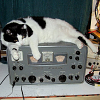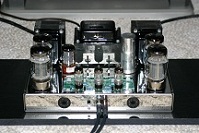Looking for some input on delaying the B+ with solid state rectification. From all my reading on this forum and other forums, it looks like it is a 50/50 split. I have also read about cathode striping. My concern is with my output tubes; I have push-pull KT88s that will have around 500V for their B+. I would like some feedback from everyone.
Thanks
B+ To delay or not delay
14 posts
• Page 1 of 1
Re: B+ To delay or not delay
I would not worry about cathode stripping - unless the B+ were higher than 800V. For the paranoid, 650V may be the cut-off point. At the voltages - which most popular, output tubes run at 250V-550V, cathode stripping does not appear to be an issue.
-

kheper - KT88
- Posts: 1252
- Joined: Wed Dec 21, 2005 10:14 pm
- Location: Philly, PA
Re: B+ To delay or not delay
The stripping is a complete myth at audio tube voltage levels (it's a high power direct-heated TX tube phenomenon). Never had a commercial unit with a delay cross my bench and I don't use them. Haven't killed a tube yet.
-= Gregg =-
Fine wine comes in glass bottles, not plastic sacks. Therefore the finer electrons are also found in glass bottles.
Fine wine comes in glass bottles, not plastic sacks. Therefore the finer electrons are also found in glass bottles.
-

Geek - KT88
- Posts: 3585
- Joined: Sun Oct 21, 2007 3:01 am
- Location: Chilliwack, British Columbia
Re: B+ To delay or not delay
I agree with the previous posts regarding cathode stripping. However, with tube-type amps, I customarily install a CL-90 surge limiter in the AC supply to reduce thermal transients in the filament ckt, but it also slows B+ a bit.
Doug Criner
- dcriner
- KT88
- Posts: 309
- Joined: Mon Oct 23, 2006 4:19 pm
- Location: Illinois
Re: B+ To delay or not delay
What about the need for delay IF high B+ (>700V) and fixed bias?
Magnus
"It is always more difficult to fight against faith than against knowledge."
"It is always more difficult to fight against faith than against knowledge."
-

soundbrigade - KT88
- Posts: 1760
- Joined: Mon Jan 28, 2008 4:57 am
- Location: Little Paris, Sweden
Re: B+ To delay or not delay
Ooops! rong thread! 





Last edited by soundbrigade on Mon Mar 24, 2014 12:45 am, edited 1 time in total.
Magnus
"It is always more difficult to fight against faith than against knowledge."
"It is always more difficult to fight against faith than against knowledge."
-

soundbrigade - KT88
- Posts: 1760
- Joined: Mon Jan 28, 2008 4:57 am
- Location: Little Paris, Sweden
Re: B+ To delay or not delay
Hi Magnus,
If it's a DH tube, the delay of a tube rectifier is fine. Ham transmitters I've worked on using a pair of 6146 in the arse end use 700 to 900V on the anodes, no delay and SS PSU's with no soft-start.
Cheers!
soundbrigade wrote:What about the need for delay IF high B+ (>700V) and fixed bias?
If it's a DH tube, the delay of a tube rectifier is fine. Ham transmitters I've worked on using a pair of 6146 in the arse end use 700 to 900V on the anodes, no delay and SS PSU's with no soft-start.
Cheers!
-= Gregg =-
Fine wine comes in glass bottles, not plastic sacks. Therefore the finer electrons are also found in glass bottles.
Fine wine comes in glass bottles, not plastic sacks. Therefore the finer electrons are also found in glass bottles.
-

Geek - KT88
- Posts: 3585
- Joined: Sun Oct 21, 2007 3:01 am
- Location: Chilliwack, British Columbia
Re: B+ To delay or not delay
Thanks everyone.
I'm thinking of using the CL-90 in the circuit. I have used them before in some other builds.
Dave
I'm thinking of using the CL-90 in the circuit. I have used them before in some other builds.
Dave
-

skidave - Posts: 141
- Joined: Fri Jan 06, 2006 2:04 pm
- Location: York, PA
Re: B+ To delay or not delay
Dave, I install a CL-90 in all my amps or other tube-type equipment - not for cathode stripping, but to make the turn-on transients easier on the filament. I don't know of any published studies backing this up as prolonging longevity, but it makes sense to me.
I think when an incandescent lamp burns out, it usually happens at turn on - we've all experienced the flash that sometimes occurs at turn on. Other possibilities would be: a. when the lamp is running, fully warmed up, but I haven't noticed that, or b. when the lamp is just sitting there, unpowered, which seems slightly ridiculous. A tube's heater or filament is essentially comparable to an incandescent lamp, right?
A CL-90 might also extend the life of incandescent dial lamps installed in tube-type equipment. And, a CL-90 might allow installing power-supply filter caps with higher value than the maximum specified by tube data sheets.
I think when an incandescent lamp burns out, it usually happens at turn on - we've all experienced the flash that sometimes occurs at turn on. Other possibilities would be: a. when the lamp is running, fully warmed up, but I haven't noticed that, or b. when the lamp is just sitting there, unpowered, which seems slightly ridiculous. A tube's heater or filament is essentially comparable to an incandescent lamp, right?
A CL-90 might also extend the life of incandescent dial lamps installed in tube-type equipment. And, a CL-90 might allow installing power-supply filter caps with higher value than the maximum specified by tube data sheets.
Doug Criner
- dcriner
- KT88
- Posts: 309
- Joined: Mon Oct 23, 2006 4:19 pm
- Location: Illinois
Re: B+ To delay or not delay
skidave wrote:Thanks everyone.
I'm thinking of using the CL-90 in the circuit. I have used them before in some other builds.
Dave
Dave - sorry mate, you'll have to bear the brunt of my rant about CL90 and how guys just say "add a CL90" without really knowing what they are saying.
CL90 is one of the range of Inrush Current Limiters.
They work by having a large cold resistance (at turn on) and a low resistance when hot.
To get them up to the "hot" operating temperature is is important to choose the device based upon the expected operating current. It is NOT a one size fits all thing.
CL90 exhibits a resistance of 120 Ohms at 25 degrees C and is suitable for operating currents between 0.5 Amps RMS and a maximum of 2 Amps RMS.
See the data sheet for other Current Limiters suitable for other currents.
http://www.mouser.com/ds/2/168/920-325D-LR-245176.pdf
For Currents of less than 0.5 Amps or more than 2.0 Amps then CL90 is NOT suitable and you need to choose one of the other Current Limiters in the range.
For more limiting it is possible to use 2 or more Current Limiters in series BUT you MUST never use them in parallel (the one which heats first would just hog all the current and if the current is high enough would self destruct)
In the day job I used 3 in series in an Airborne Laser Power Supply to limit the peak current draw (at switch on) from the aircraft 28V DC supply. The regulatory authorities (FAA in the US and CASA here in Oz) get really "shitty" about popping aircraft fuses/circuit breakers and insist on a safe design. Having to fly in those same aircraft I'm not complaining about that.
I used then Rhopoint Components SG "Surge Guard" Series but they same.
http://www.rhopointcomponents.com/surge ... eries.html
Cheers,
Ian
- Gingertube
- Posts: 245
- Joined: Thu Oct 05, 2006 10:27 pm
- Location: Adelaide, South Oz
Re: B+ To delay or not delay
What about with direct-coupled circuits, such as the commonly used grounded cathode direct-coupled to a cathode follower with 400V B+? Prior to the heaters warming up, there would be the full B+ voltage at the grid of the cathode follower, much closer to the cathode than the plate. Any problems with this? I'm asking because I've seen some of these circuits using neon bulbs after the plate resistor of the voltage amplifier to drop some voltage until the tubes warm up and start conducting. At that point voltage drops below the level required to activate the neon bulb and it is effectively out of the circuit.
- Kyle K
- Posts: 29
- Joined: Tue May 09, 2006 2:38 pm
- Location: Mililani, HI
Re: B+ To delay or not delay
Whether or not you delay the B+ you should include grid to cathode max voltage protection such as the neon from grid to cathode on DC coupled cathode followers. Also for DC coupled concertina phase splitters etc.
The more usual reason to delay B+ these days is to get away with lower voltage rating filter caps.
With no current draw you get 1.4 x V secondary for the B+. Once the tubes have warmed up and are conducting current, then B+ is more like 1.1 to 1.2 V secondary. With delayed B+ you can get away with lower voltage rating caps in the supply and sometimes avoid having to series connect caps to get the voltage withstand. Of-course you if you rely on this then can't do set to work testing or servicing work with the tubes removed without risking blowing up the B+ Filter Capacitors which in my view makes it a "crap" idea.
Rate the filter caps to withstand the 0V current startup voltage and don't bother with delayed B+.
Cheers,
Ian
The more usual reason to delay B+ these days is to get away with lower voltage rating filter caps.
With no current draw you get 1.4 x V secondary for the B+. Once the tubes have warmed up and are conducting current, then B+ is more like 1.1 to 1.2 V secondary. With delayed B+ you can get away with lower voltage rating caps in the supply and sometimes avoid having to series connect caps to get the voltage withstand. Of-course you if you rely on this then can't do set to work testing or servicing work with the tubes removed without risking blowing up the B+ Filter Capacitors which in my view makes it a "crap" idea.
Rate the filter caps to withstand the 0V current startup voltage and don't bother with delayed B+.
Cheers,
Ian
- Gingertube
- Posts: 245
- Joined: Thu Oct 05, 2006 10:27 pm
- Location: Adelaide, South Oz
Re: B+ To delay or not delay
Kyle K wrote:What about with direct-coupled circuits, such as the commonly used grounded cathode direct-coupled to a cathode follower with 400V B+? Prior to the heaters warming up, there would be the full B+ voltage at the grid of the cathode follower, much closer to the cathode than the plate. Any problems with this? I'm asking because I've seen some of these circuits using neon bulbs after the plate resistor of the voltage amplifier to drop some voltage until the tubes warm up and start conducting. At that point voltage drops below the level required to activate the neon bulb and it is effectively out of the circuit.
That could be a major problem, and is a good reason to include some sort of Vpp control when using SS power supplies. For such a project, I included separate heater supplies so the cathodes could come up to operating temp before the main supply is turned on.
Live Free or Die: Linux
-

Impmon - Posts: 68
- Joined: Sat Jun 14, 2008 8:05 pm
- Location: The Midwest
Re: B+ To delay or not delay
I researched this extensively. The closest thing to hard evidence I found led me to this conclusion: Cathode stripping does not occur at voltages under 700 volts. Hardly anyone operates audio gear at a level sufficient to worry about cathode stripping.
Of far greater concern is cathode POISONING: Caused by having the heaters on but no voltage across the tubes. I found reference to cathode poisoning on one or two of the few reasonably authoritative articles on cathode stripping I came across. I have used all manner of power tubes and have yet to have a power tube failure, period, except when I did something stupid. To date, all of my power tube failures were MY fault. And I do a LOT of experimenting.
If you are doing audiophile (versus guitar) I recommend solid state. The "firmer" you get the B+, ESPECIALLY in the preamp section, the better your sound quality. I only do push-pull amps, otherwise I would recommend regulation for the power tubes as well.
Of far greater concern is cathode POISONING: Caused by having the heaters on but no voltage across the tubes. I found reference to cathode poisoning on one or two of the few reasonably authoritative articles on cathode stripping I came across. I have used all manner of power tubes and have yet to have a power tube failure, period, except when I did something stupid. To date, all of my power tube failures were MY fault. And I do a LOT of experimenting.
If you are doing audiophile (versus guitar) I recommend solid state. The "firmer" you get the B+, ESPECIALLY in the preamp section, the better your sound quality. I only do push-pull amps, otherwise I would recommend regulation for the power tubes as well.
- Jerryz1963
- Posts: 5
- Joined: Sun May 11, 2014 1:54 am
14 posts
• Page 1 of 1
Who is online
Users browsing this forum: No registered users and 13 guests
